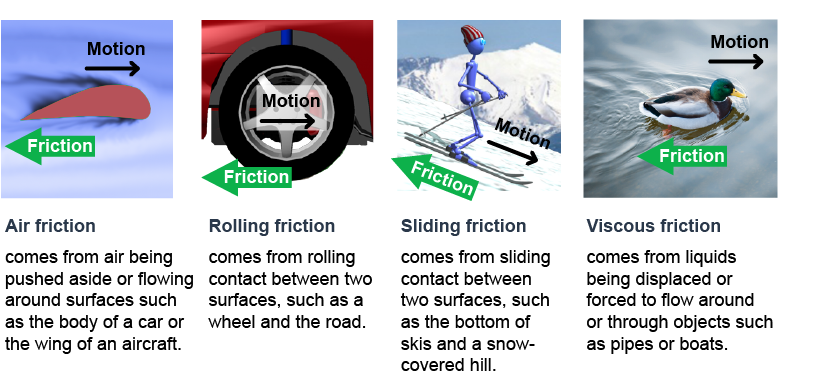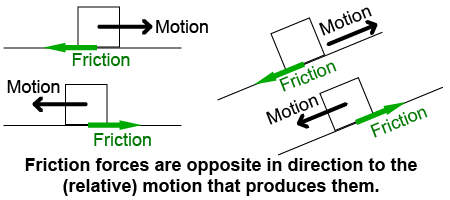|
Friction is not a specific force in the same way that gravity is a force between two masses. Instead, friction is a “catch-all” term that collectively refers to forces that may be caused by motion and that act to reduce motion. Friction transforms the energy of motion into thermal energy or the wearing away of moving surfaces. Kinetic friction describes the friction between sliding surfaces and rolling friction describes friction in wheels. Static friction describes the tendency of objects to stick to each other and not move until a minimum force is applied to “break things loose.” 
|
Some causes of friction
|
Everything that moves in the macroscopic world feels friction. We model the effect of friction as a force that is opposite in direction from actual motion, or the motion that might occur if there were no friction. Sliding, moving through air or water, or rolling are some forms of motion that generate friction that we can model this way. 
|

|
On a microscopic level friction comes from atomic-scale attraction between adjacent particles of matter. Slippery liquids such as oil can reduce friction but even the slipperiest oil cannot eliminate friction altogether. The only way to eliminate friction is to eliminate the relative motion of matter—such as by traveling through deep space where there is no air, and therefore no matter. 
|
 If you know the direction of motion, then the force of friction will be in the opposite direction. (More specifically, the force of friction between two surfaces is opposite to the relative motion between the two surfaces.) If a box slides to the left, the force of sliding friction points to the right. If an object is falling down, the force of air friction points up. If the direction of motion is unknown, the direction of friction forces can be tricky to determine.
If you know the direction of motion, then the force of friction will be in the opposite direction. (More specifically, the force of friction between two surfaces is opposite to the relative motion between the two surfaces.) If a box slides to the left, the force of sliding friction points to the right. If an object is falling down, the force of air friction points up. If the direction of motion is unknown, the direction of friction forces can be tricky to determine. 
 |
 The magnitude of any friction force depends on the exact conditions of the motion and the surfaces that are in contact with each other. Ice creates very low friction forces whereas rubber on dry pavement can create much larger friction forces. Even a little water and oil on a road, however, can greatly reduce the friction force between the tires and the pavement.
The magnitude of any friction force depends on the exact conditions of the motion and the surfaces that are in contact with each other. Ice creates very low friction forces whereas rubber on dry pavement can create much larger friction forces. Even a little water and oil on a road, however, can greatly reduce the friction force between the tires and the pavement. 
|

